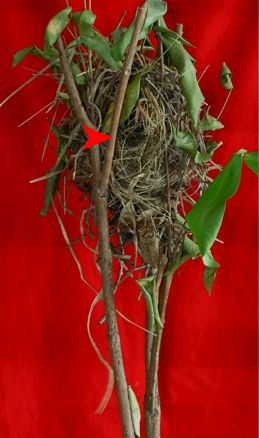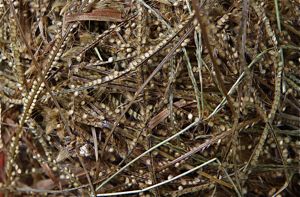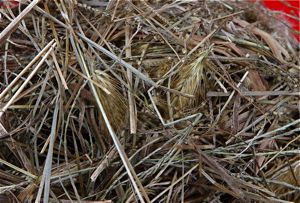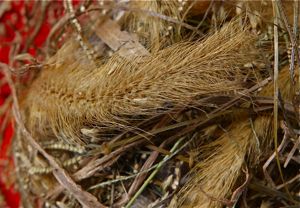On 5th May 2008, Tan Teo Seng sent me a used munia nest that he collected from his fruit farm in Johor while pruning his jambu air or water apple (Syzygium aqueum) tree. The nest was lodged between the narrow forks of two pairs of slender branches about 3 metres from the ground.
The nest, a roundish structure of 150×150 mm, has a small oval opening of 35×40 mm near the top, about half way up (above left, arrow). The entrance is slightly directed downwards and not at all obvious, with an untidy overhang of dried leaves to camouflage it. The image on the right, above, shows the nest from the back.
The nest proper sits on a 50 mm thick base of leaves and twigs, comprising of a total of 34 pieces of branch tips, each with two to five leaves still attached. Mixed with these are 18 pieces of short twigs, most of which are short-branched rather than single pieces.
The outer layer of the nest is made up of a total of 220 dried grass leaves, mostly 300 mm long, the longest being 450 mm. These are weaved together to provide a firm shell. The removal of these leaves exposes the inner oval ball, 140×110 mm, made up entirely of grass inflorescence branches, complete with spikelets.
The grasse are Buffalo Grass (Paspalum conjugatum) 281 pieces (left top); Creeping Panic Grass (Panicum repens) 79 pieces; Elephant Grass (Pennisetum purpureum) 17 pieces (left middle and bottom); Lalang (Imperata cylindrical) 22 pieces; and Panicum humidorum 73 pieces.
The nest chamber is 60×50 mm. Inside are three eggs, one of which hatched while two remained unhatched, with ants around one that has cracked (below).
The total number of the different nesting materials that make up the nest is 744. This is very much less than the usual number of pieces of materials of this size. Why? Because most of the materials are extremely long, especially the grass leaves.
According to Restall (1996), “In most, if not all species, the male brings the nesting material to the nest, while the female inside works it into place by pushing. This pushing may extend to a kind of weaving when a length of grass may be pulled back into the structure and thus loops, catching hold, but the munias are not authentic weavers.”
What this means is that the male bird would need to make a total of around 679 trips to bring all the materials to the female to construct the nest. The female would be working just as hard to get the materials brought by the male into place to construct this large nest.
An earlier nest looks about the same but made of slightly different materials.
Reference:
Restall, R. (1996). Munias and mannikins. East Sussex: Pica Press.















3 Responses
Wow, this is really good to know. Amazing but lots of hard works.
Not much hard work actually. Just about an hour to count the different materials. It take more effort to list the birds in an area. The former provides much useful information, the latter merely churns out a list.